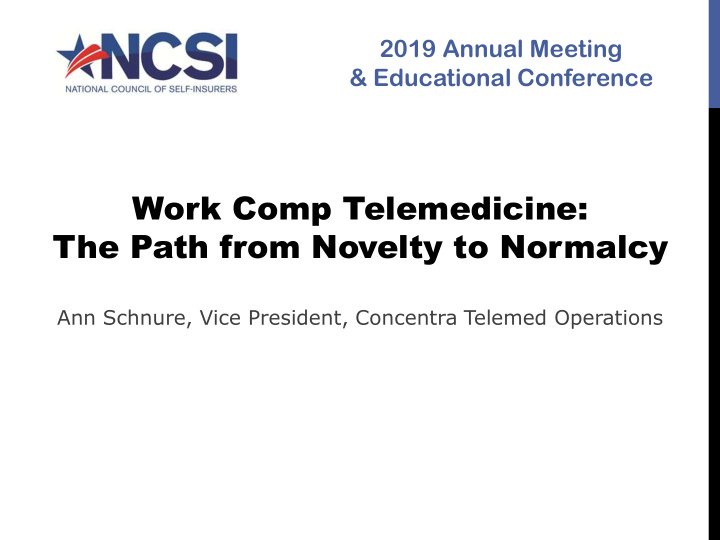



2019 Annual Meeting & Educational Conference Work Comp Telemedicine: The Path from Novelty to Normalcy Ann Schnure, Vice President, Concentra Telemed Operations
FAVORABLE ENVIRONMENT WILL FACILITATE GROWTH Growing acceptance by consumers and regulators • All states have adopted telemedicine in some form with an increasing number accepting telemedicine for WC • Telemedicine licensure compact covering numerous states facilitates broader physician licensing Work comp telemedicine Group Health following typical uptake Telemedicine model * for new innovations Work Comp Telemedicine Innovators Early Early Late Laggards Adopters Majority Majority *Rogers Diffusion of Innovation
STRONG RECEPTIVITY GOING MAINSTREAM 75% 54% 80% 54% of workers’ Over 75% of health delivery Nearly 80% of large organizations, such as compensation professionals, employers (defined as 1,000 physician groups and such as TPAs and brokers, or more employees) use hospitals, use or plan to use say telehealth and telemedicine and expected to jump to over 90% by 2019. 3 telemedicine in the near telemedicine will be most future. 1 useful in containing health care costs. 2 1-Vidyo 2018 survey of health delivery organizations 2- Mitchell and Risk & Insurance magazine 2017 survey of workers’ compensation professionals 3-Willis Towers Watson 2017 Best Practices in Health Care Employer Survey
KEY DIFFERENCES BETWEEN GROUP VS WORK COMP TELEMEDICINE Key Differences • Direct to patient vs intermediaries involved Group Health • Group health telemedicine often includes Telemedicine peripherals, kiosks, or wearables • State work comp divisions provide additional oversight in work comp telemedicine • Billing and reimbursement • Group offerings typically payor driven with single platform option Work Comp Telemedicine Similarities • High satisfaction rates among users • Need robust communication and roll out to facilitate awareness and use
WORK COMP TELEMEDICINE: REGULATORY PERSPECTIVE No nationwide acceptance for work comp telemedicine Great variation state by state • State regulations: Some states do not allow or are very restrictive; becoming more open slowly and with education • State forms: Need a way for patients to complete state specific forms electronically; state must accept e- signature as well
WORK COMP TELEMEDICINE: VARIETY OF AVAILABLE OPTIONS Key considerations VS VS Occ med Generalist VS VS Single visit Continuity of care VS VS Phone * Video Available models Triage Only Recheck Only One-and-done Comprehensive • Widely accepted • Patient must first get • Typically staffed by • Occ med experts in-person care generalist • Limited scope • Patient may begin • May or may not • No continuity for and continue in • May be phone or maintain continuity of follow-up care telemedicine video care • May be phone or • Video for full • Typically video video treatment
WORK COMP TELEMEDICINE: THERAPY • Physical therapist interacts with patient to conduct initial injury assessment and observe treatment progression. • Post-visit instructional videos may complement the visit, providing patients with a reference for at-home exercises. • Synchronous and asynchronous available. Benefits • Convenience • Accessibility • Compliance
WORK COMP TELEMEDICINE: COMMON QUESTIONS • What can be treated? • Can an adequate evaluation be made via video? • What happens if additional visits are required? • How secure is telemedicine for injury care? • Is there any legal risk involved? • Is it easy to implement? • Will employees use and like it? • Will it save me money?
WORK COMP TELEMEDICINE: MYTHS AND MISCONCEPTIONS • Telemedicine is only used for triage or first aid. • A thorough physical exam isn’t possible via telemedicine. • The primary benefit of telemedicine is to address after hours care. • Following an after hours telemedicine visit, the patient should be transferred to a brick-and-mortar facility. • Telemedicine can’t be used to treat an entire work injury case.
WORK COMP TELEMEDICINE: OUR EXPERIENCE
WORK COMP TELEMEDICINE: FREQUENTLY CITED BENEFITS Access and Convenience Cost Timely access to care, Fewer emergency • • especially in remote department or in-person locations or after hours urgent care visits Employees can receive care Reduced case duration • • at the workplace, at home, Improved productivity • or on the road No need to arrange • transportation
WORK COMP TELEMEDICINE: KEY CONSIDERATIONS Tech/equipment Workflow • • HIPAA-compliant Ensure specific employer workflow • is followed Video and audio • Supports workflows • Supports electronic medical records Communication (EMR) • Patient has clear instructions on • Actionable reporting return-to-work (RTW) process and • home exercise program 24/7 support • Employer notified immediately on RTW to support injured worker Experience of provider • TPA/payor/managed care receives • Expertise and experience in timely clinical information to support workers’ compensation care continuum • Embrace telemedicine and technology • Utilize same EMR across network for continuity of care • Confirm in-network with payor
WORK COMP TELEMEDICINE: FOCUSED IMPLEMENTATION REQUIRED TO ENABLE UPTAKE • Choose your provider wisely Pre-planning • Occupational health expertise and experience matter • Confirm understanding of state regulations to ensure best practices are followed • Understand fees (equipment, technology, visit) • Understand equipment needs and provide a private space • Education Identify and engage advocates within your organization • Leverage existing processes and workflows • Explain telemedicine work flow/process to stakeholders • Get buy-in from leadership Build • Promote your telemedicine offerings awareness • Provide resources so injured worker knows how to get to care • Develop streamlined and integrated process The patient • Ensure user-friendly approach experience • Monitoring Keep stakeholders informed of RTW post-visit • Review results (e.g., outcomes, satisfaction, etc.) and reporting • Identify areas for improvement
WORK COMP TELEMEDICINE: EMERGING AREAS • Wearables • Peripherals • Additional use cases • Behavioral health • Bloodborne pathogen exposure • Travel health • Post-operative recovery • Specialist
Q&A
Recommend
More recommend